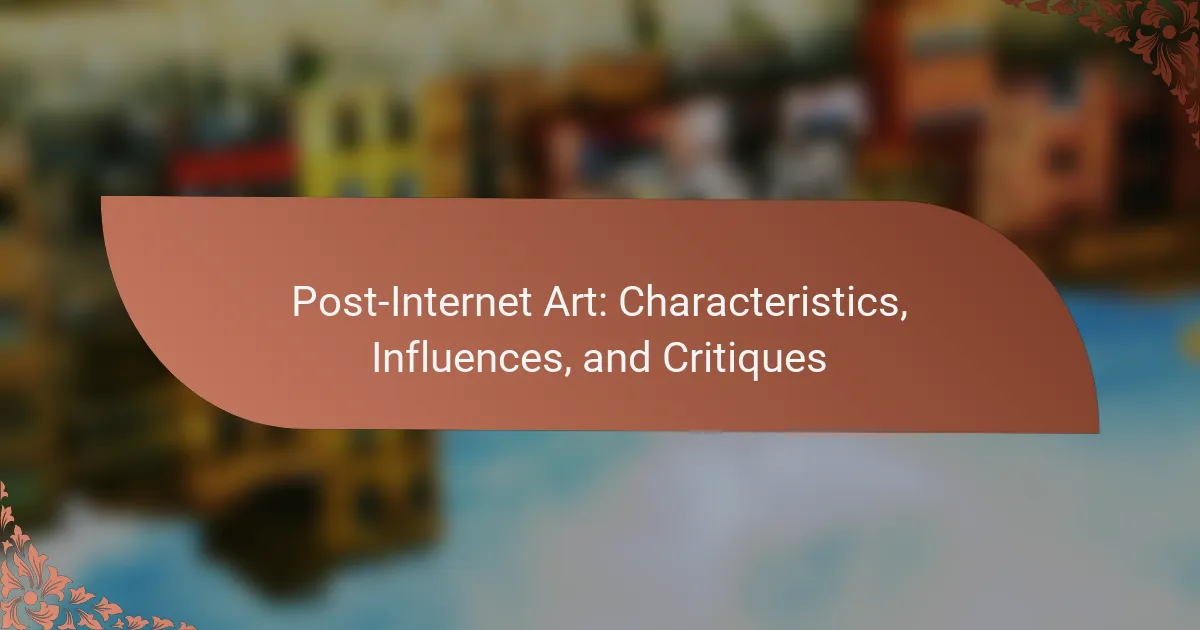Post-Internet Art reflects the profound influence of digital culture on artistic expression. It blends traditional and digital mediums while critiquing consumerism and exploring identity. Influenced by technology and social media, it raises questions about authenticity and accessibility. This article examines its characteristics, key figures, cultural contexts, and critiques, highlighting the ongoing dialogue between art and the digital landscape.
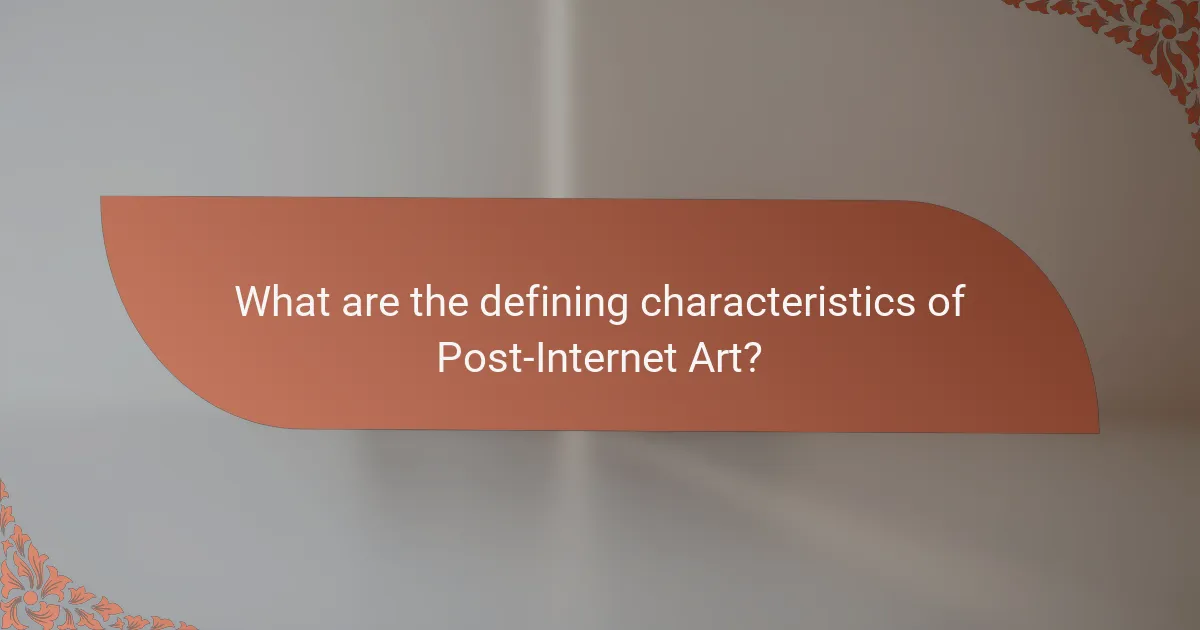
What are the defining characteristics of Post-Internet Art?
Post-Internet Art is characterized by its engagement with digital culture and the internet’s impact on art. Key characteristics include a blend of traditional and digital mediums, commentary on consumerism, and the exploration of identity in a hyper-connected world. Influences stem from technology, social media, and contemporary issues, shaping its themes and aesthetics. Critiques often focus on the commodification of art and the challenges of authenticity in a digital landscape.
How does Post-Internet Art reflect digital culture?
Post-Internet Art reflects digital culture by exploring the intersection of online and offline experiences. It critiques traditional art forms while embracing digital aesthetics, often utilizing internet memes and social media. This art movement highlights the pervasive influence of technology on identity and communication. By engaging with the digital landscape, Post-Internet Art challenges notions of authorship and originality, emphasizing collaboration and remix culture. The unique attributes of this genre include its adaptability and responsiveness to current digital trends, making it a significant commentary on contemporary society.
In what ways does Post-Internet Art challenge traditional art forms?
Post-Internet Art challenges traditional art forms by incorporating digital technology and online culture. It blurs the lines between creator and audience, emphasizing participation and interaction. This art form often critiques commercialism and the commodification of art, questioning established value systems. Additionally, it utilizes diverse mediums, including social media, video, and installation, which contrasts with conventional art’s reliance on physical spaces. The unique attribute of Post-Internet Art lies in its ability to reflect contemporary society’s digital experiences.
What role do technology and social media play in Post-Internet Art?
Technology and social media are integral to Post-Internet Art, shaping its creation and dissemination. Artists utilize digital platforms to reach wider audiences and engage in dialogue. The unique attribute of this art form is its reliance on online interactions, which influence both the content and reception of artworks. Social media allows for instant feedback, fostering a collaborative environment that challenges traditional art critiques. As a result, Post-Internet Art reflects contemporary digital culture, merging virtual and physical experiences.
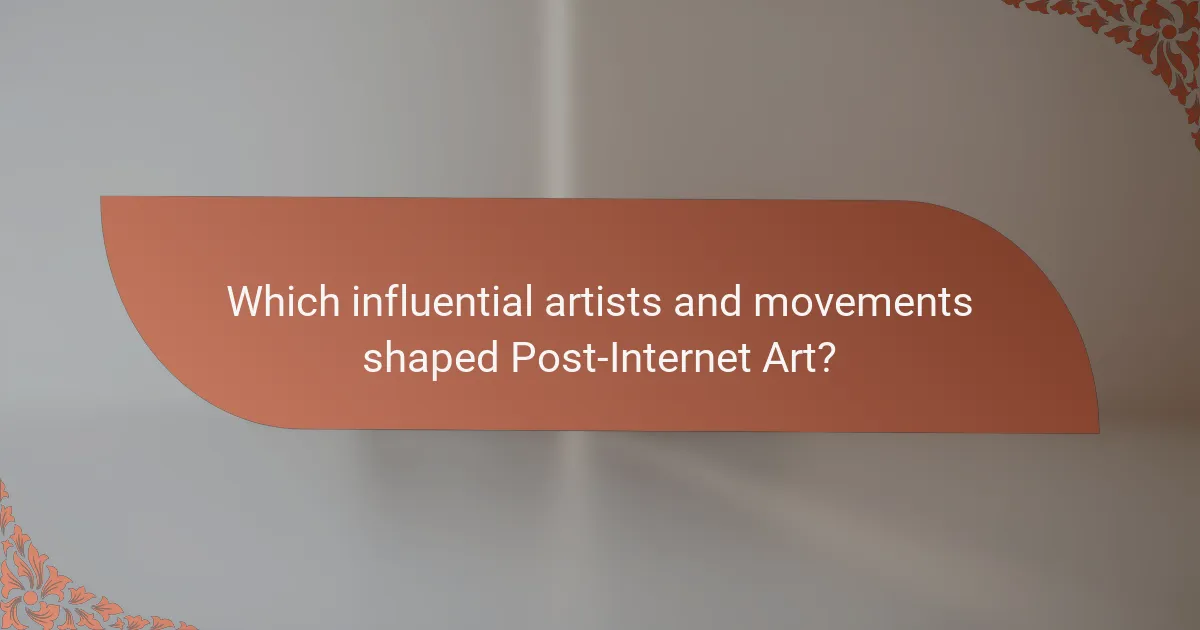
Which influential artists and movements shaped Post-Internet Art?
Post-Internet Art has been shaped by influential artists and movements like conceptual art, net art, and digital culture. Key figures include Cory Arcangel, Rafael Rozendaal, and JODI, who explore themes of technology and identity. The movement reflects a blend of traditional art forms and contemporary digital practices, emphasizing the impact of the internet on artistic expression. Notable influences include the rise of social media and the democratization of art production and distribution, which challenge conventional art paradigms.
How have global art trends influenced Post-Internet Art practices?
Global art trends have significantly shaped Post-Internet Art practices by emphasizing digital engagement and interdisciplinary approaches. Artists incorporate social media, technology, and internet culture into their work, reflecting contemporary society’s complexities. The rise of global connectivity fosters collaboration and challenges traditional art forms, leading to innovative expressions. As a result, Post-Internet Art often critiques digital culture while embracing its aesthetics, creating a dialogue between the virtual and physical realms.
What is the significance of online platforms for Post-Internet artists?
Online platforms are crucial for Post-Internet artists as they facilitate global exposure and interaction. These platforms enable artists to share their work, engage with diverse audiences, and receive instant feedback. This accessibility enhances collaboration and experimentation, fostering a dynamic art community. Moreover, online platforms often reflect the digital nature of Post-Internet art, emphasizing its themes of connectivity and technology. The unique attribute of these platforms is their ability to democratize art, allowing emerging artists to gain visibility without traditional gatekeeping.
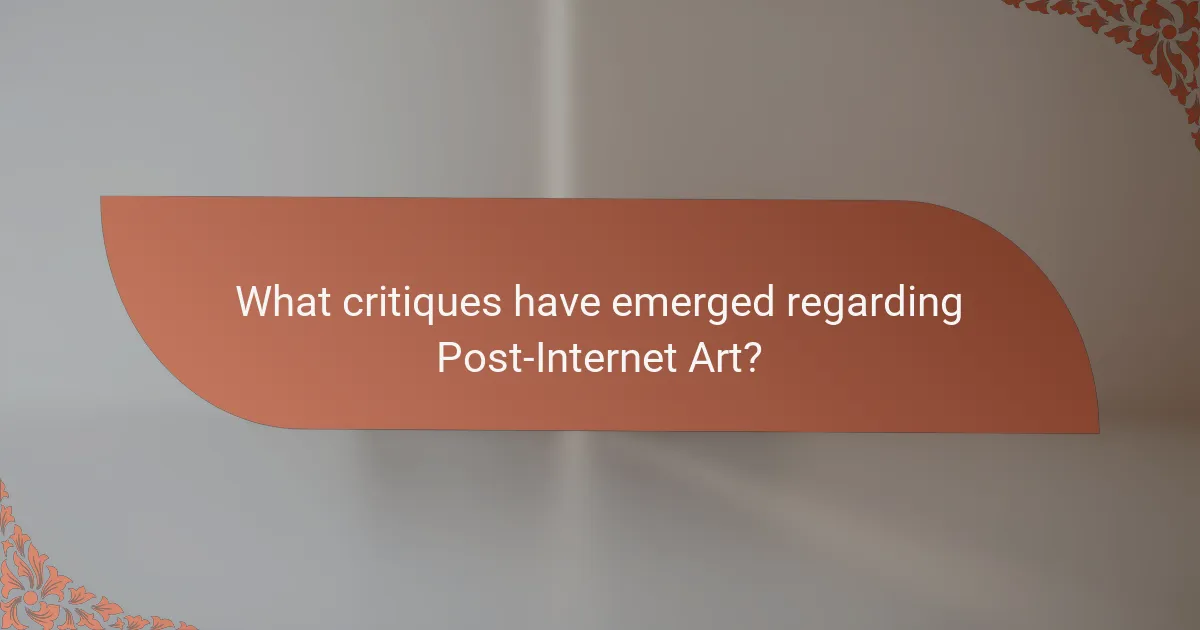
What critiques have emerged regarding Post-Internet Art?
Critiques of Post-Internet Art often focus on its commercialization and lack of originality. Critics argue that the movement can prioritize aesthetic over substance, leading to works that feel superficial. Additionally, the reliance on digital platforms raises concerns about accessibility and the potential exclusion of non-digital artists. Some believe it reflects a consumerist culture, diluting the critical potential of art. Others highlight the challenge of defining authenticity in an era of replication and remixing.
How do critics view the commodification of digital art?
Critics often view the commodification of digital art as a double-edged sword. On one hand, it democratizes access to art and enables artists to monetize their work. On the other hand, it raises concerns about authenticity and the dilution of artistic value. Critics argue that the market-driven approach may prioritize profit over creativity, leading to a homogenization of artistic expression. Additionally, the reliance on technology can overshadow traditional art forms, prompting debates about the true nature of art in a digital age.
What ethical considerations arise in the context of Post-Internet Art?
Ethical considerations in Post-Internet Art include issues of authorship, appropriation, and digital ownership. Artists often navigate the blurred lines of originality and copyright due to the remix culture fostered by the internet. As a result, the accessibility of digital tools raises questions about the democratization of art versus the potential for exploitation. Additionally, the impact of algorithm-driven platforms on visibility and value complicates the relationship between creators and audiences. These factors highlight the need for ongoing dialogue about ethics in the evolving landscape of contemporary art.
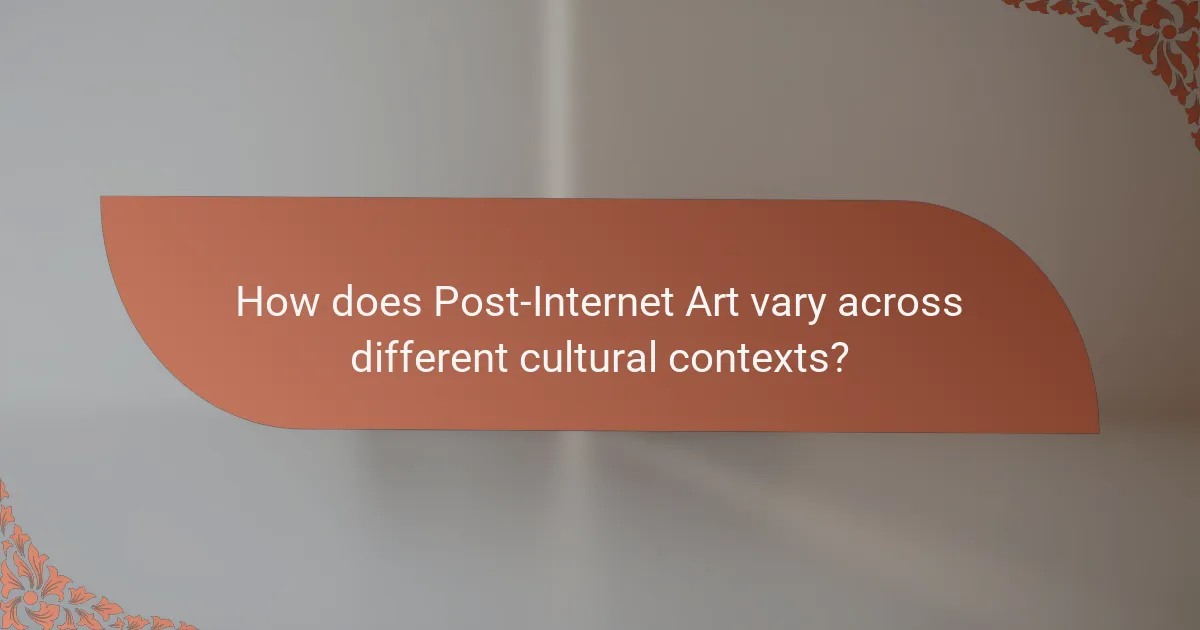
How does Post-Internet Art vary across different cultural contexts?
Post-Internet Art varies significantly across cultural contexts due to differing societal influences and technological access. In Western cultures, it often critiques consumerism and digital identity, while in non-Western regions, it may focus on local narratives and community engagement.
Cultural context shapes the themes and mediums used in Post-Internet Art. For example, artists in urban environments may utilize digital tools to reflect the fast-paced lifestyle, while those in rural areas might incorporate traditional techniques to address local issues.
Globalization has created a dialogue between cultures, leading to hybrid forms of Post-Internet Art. Artists blend local traditions with global influences, resulting in unique expressions that reflect both cultural heritage and contemporary issues.
Critiques of Post-Internet Art also vary. In some cultures, it is seen as a tool for social change, while in others, it may be criticized for elitism or detachment from everyday life. This divergence highlights the importance of understanding local perspectives in the appreciation of Post-Internet Art.
What are the regional differences in the reception of Post-Internet Art?
Post-Internet Art is received differently across regions due to cultural contexts and technological access. In Western countries, it often emphasizes individualism and critique of consumer culture. Conversely, in Asia, it may focus on collective identity and rapid technological advancement. These regional differences reflect unique artistic expressions and societal values. For example, European artists might explore themes of nostalgia, while artists in Africa often integrate local traditions with digital media. This diversity highlights how local influences shape the interpretation and appreciation of Post-Internet Art.
Which local artists are redefining Post-Internet Art in their communities?
Local artists redefining Post-Internet Art often incorporate digital mediums and community engagement. Notable figures include Casey Reas, who explores algorithmic art, and Amalia Ulman, known for her social media performances. Their work reflects unique attributes of localized digital culture, influencing perceptions of art in urban environments. Additionally, artists like Jon Rafman challenge traditional narratives through immersive installations, showcasing the rare intersection of technology and human experience.
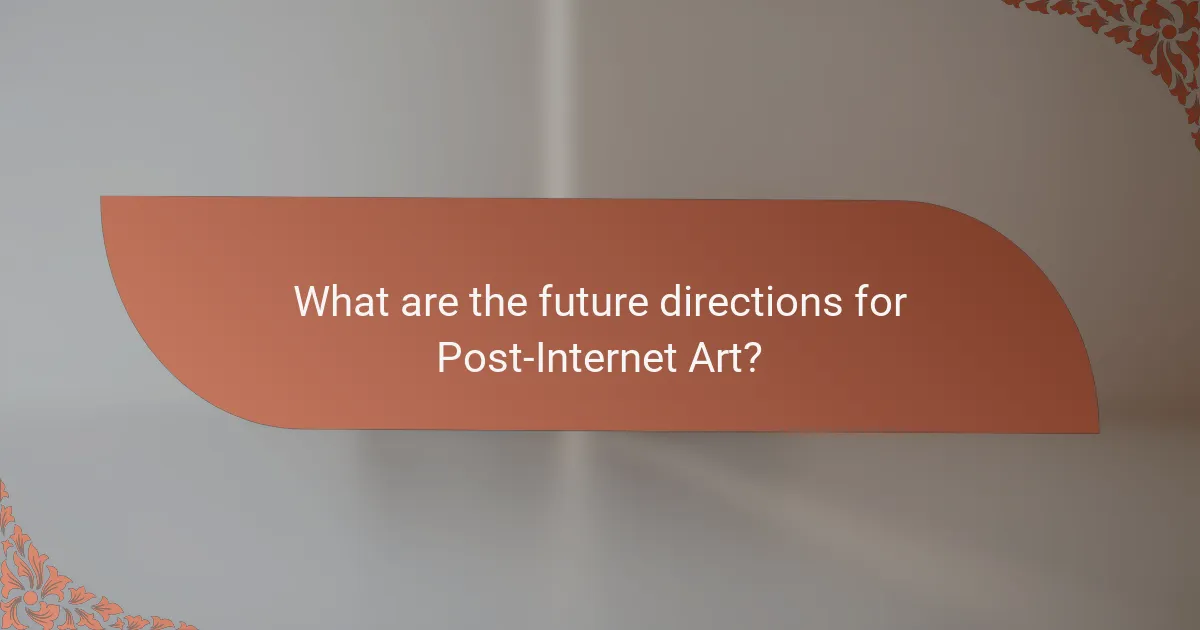
What are the future directions for Post-Internet Art?
Post-Internet Art will increasingly explore themes of digital identity, sustainability, and the impact of artificial intelligence. Artists will likely focus on the intersection of technology and human experience, emphasizing community engagement and social commentary. Collaborations across disciplines, such as technology, science, and traditional art forms, will shape future works. Additionally, the rise of virtual and augmented reality may redefine how audiences interact with art, creating immersive experiences that challenge conventional perceptions.
How might emerging technologies influence the evolution of Post-Internet Art?
Emerging technologies significantly influence the evolution of Post-Internet Art by reshaping its creation and distribution methods. Digital tools and platforms enable artists to explore new mediums like virtual reality and artificial intelligence. These technologies facilitate interactive experiences, allowing audiences to engage more deeply with art. Furthermore, the accessibility of online platforms democratizes art distribution, enabling broader participation and dialogue. As a result, Post-Internet Art continues to evolve, reflecting contemporary societal shifts and technological advancements.
What best practices can artists adopt in the Post-Internet Art landscape?
Artists in the Post-Internet Art landscape should embrace digital tools, engage with online communities, and prioritize conceptual depth. These practices enhance visibility and relevance.
1. Utilize social media for portfolio showcasing and audience engagement.
2. Experiment with multimedia formats, including video and interactive installations.
3. Collaborate with other artists across digital platforms to broaden creative perspectives.
4. Reflect on the impact of technology on society to inform artistic themes.
5. Stay informed about trends in digital culture to remain relevant.
